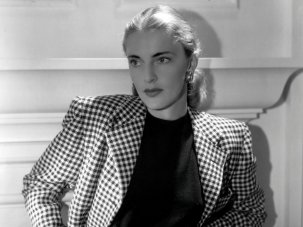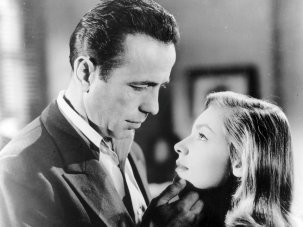from Sight & Sound Winter 1974/75
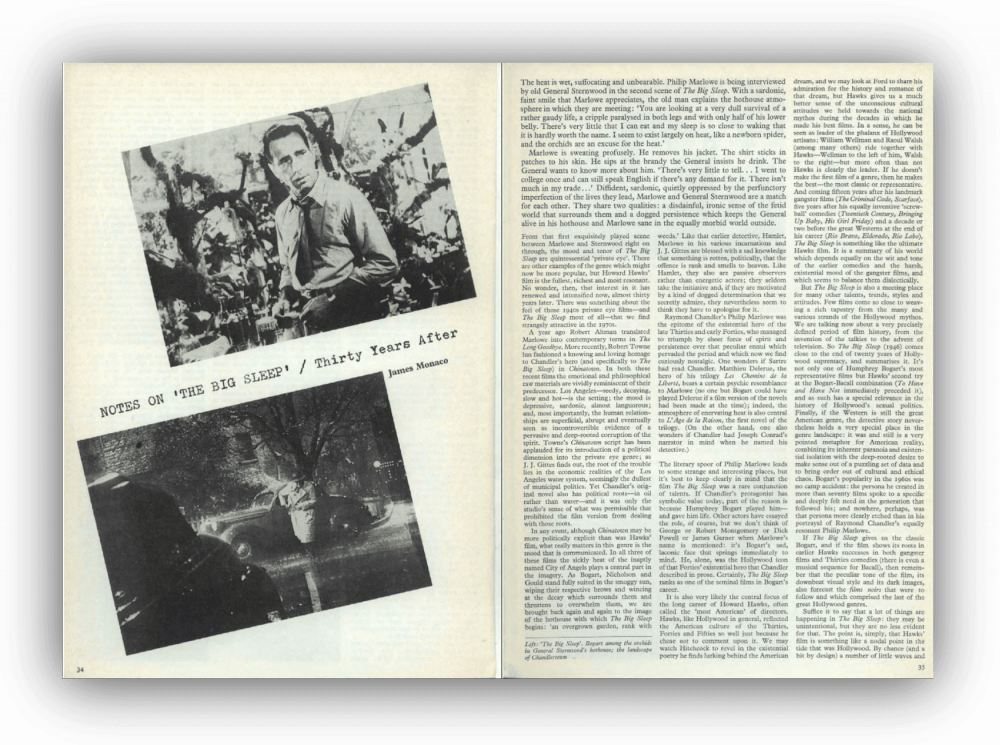
The heat is wet, suffocating and unbearable. Philip Marlowe is being interviewed by old General Sternwood in the second scene of The Big Sleep. With a sardonic, faint smile that Marlowe appreciates, the old man explains the hothouse atmosphere in which they are meeting: “You are looking at a very dull survival of a rather gaudy life, a cripple paralysed in both legs and with only half of his lower belly. There’s very little that I can eat and my sleep is so close to waking that it is hardly worth the name. I seem to exist largely on heat, like a newborn spider, and the orchids are an excuse for the heat.”
Marlowe is sweating profusely. He removes his jacket. The shirt sticks in patches to his skin. He sips at the brandy the General insists he drink. The General wants to know more about him. “There’s very little to tell… I went to college once and can still speak English if there’s any demand for it. There isn’t much in my trade…” Diffident, sardonic, quietly oppressed by the perfunctory imperfection of the lives they lead, Marlowe and General Sternwood are a match for each other. They share two qualities: a disdainful, ironic sense of the fetid world that surrounds them and a dogged persistence which keeps the General alive in his hothouse and Marlowe sane in the equally morbid world outside.
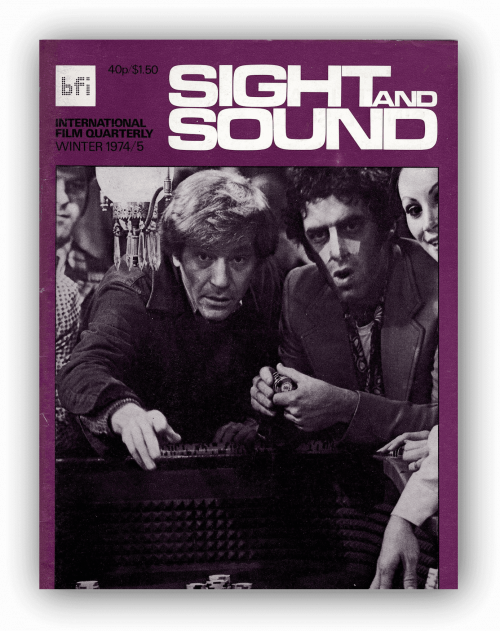
Sight & Sound, Winter 1974
From that first exquisitely played scene between Marlowe and Sternwood right on through, the mood and tenor of The Big Sleep are quintessential ‘private eye’. There are other examples of the genre which might now be more popular, but Howard Hawks’ film is the fullest, richest and most resonant. No wonder, then, that interest in it has renewed and intensified now, almost 30 years later. There was something about the feel of those 1940s private eye films – and The Big Sleep most of all – that we find strangely attractive in the 1970s.
A year ago Robert Altman translated Marlowe into contemporary terms in The Long Goodbye. More recently, Robert Towne has fashioned a knowing and loving homage to Chandler’s hero (and specifically to The Big Sleep) in Chinatown. In both these recent films the emotional and philosophical raw materials are vividly reminiscent of their predecessor. Los Angeles – seedy, decaying, slow and hot – is the setting; the mood is depressive, sardonic, almost languorous; and, most importantly, the human relationships are superficial, abrupt and eventually seen as incontrovertible evidence of a pervasive and deep-rooted corruption of the spirit. Towne’s Chinatown script has been applauded for its introduction of a political dimension into the private eye genre; as J.J. Gittes finds out, the root of the trouble lies in the economic realities of the Los Angeles water system, seemingly the dullest of municipal politics. Yet Chandler’s original novel also has political roots – in oil rather than water – and it was only the studio’s sense of what was permissible that prohibited the film version from dealing with those roots.
In any event, although Chinatown may be more politically explicit than was Hawks’ film, what really matters in this genre is the mood that is communicated. In all three of these films the sickly heat of the inaptly named City of Angels plays a central part in the imagery. As Bogart, Nicholson and Gould stand fully suited in the smoggy sun, wiping their respective brows and wincing at the decay which surrounds them and threatens to overwhelm them, we are brought back again and again to the image of the hothouse with which The Big Sleep begins: “an overgrown garden, rank with weeds.” Like that earlier detective, Hamlet, Marlowe in his various incarnations and J.J. Gittes are blessed with a sad knowledge that something is rotten, politically, that the offence is rank and smells to heaven. Like Hamlet, they also are passive observers rather than energetic actors; they seldom take the initiative and, if they are motivated by a kind of dogged determination that we secretly admire, they nevertheless seem to think they have to apologise for it.
Raymond Chandler’s Philip Marlowe was the epitome of the existential hero of the late 30s and early 40s, who managed to triumph by sheer force of spirit and persistence over that peculiar ennui which pervaded the period and which now we find curiously nostalgic. One wonders if Sartre had read Chandler. Matthieu Delerue, the hero of his trilogy Les Chemins de Ia liberté, bears a certain psychic resemblance to Marlowe (no one but Bogart could have played Delerue if a film version of the novels had been made at the time); indeed, the atmosphere of enervating heat is also central to L’Age de Ia Raison, the first novel of the trilogy. (On the other hand, one also wonders if Chandler had Joseph Conrad’s narrator in mind when he named his detective.)
~
The literary spoor of Philip Marlowe leads to some strange and interesting places, but it’s best to keep clearly in mind that the film The Big Sleep was a rare conjunction of talents. If Chandler’s protagonist has symbolic value today, part of the reason is because Humphrey Bogart played him and gave him life. Other actors have essayed the role, of course, but we don’t think of George or Robert Montgomery or Dick Powell or James Garner when Marlowe’s name is mentioned: it’s Bogart’s sad, laconic face that springs immediately to mind. He, alone, was the Hollywood icon of that 40s’ existential hero that Chandler described in prose. Certainly, The Big Sleep ranks as one of the seminal films in Bogart’s career.
It is also very likely the central focus of the long career of Howard Hawks, often called the ‘most American’ of directors. Hawks, like Hollywood in general, reflected the American culture of the 30s, 40s and 50s so well just because he chose not to comment upon it. We may watch Hitchcock to revel in the existential poetry he finds lurking behind the American dream, and we may look at Ford to share his admiration for the history and romance of that dream, but Hawks gives us a much better sense of the unconscious cultural attitudes we held towards the national mythos during the decades in which he made his best films.
In a sense, he can be seen as leader of the phalanx of Hollywood artisans: William Wellman and Raoul Walsh (among many others) ride together with Hawks – Wellman to the left of him, Walsh to the right – but more often than not Hawks is clearly the leader. If he doesn’t make the first film of a genre, then he makes the best – the most classic or representative. And coming 15 years after his landmark gangster films (The Criminal Code, Scarface), five years after his equally inventive ‘screw ball’ comedies (Twentieth Century, Bringing Up Baby, His Girl Friday) and a decade or two before the great westerns at the end of his career (Rio Bravo, El Dorado, Rio Lobo), The Big Sleep is something like the ultimate Hawks film. It is a summary of his world which depends equally on the wit and tone of the earlier comedies and the harsh, existential mood of the gangster films, and which seems to balance them dialectically.
But The Big Sleep is also a meeting place for many other talents, trends, styles and attitudes. Few films come so close to weaving a rich tapestry from the many and various strands of the Hollywood mythos. We are talking now about a very precisely defined period of film history, from the invention of the talkies to the advent of television. So The Big Sleep (1946) comes close to the end of 20 years of Hollywood supremacy, and summarises it. It’s not only one of Humphrey Bogart’s most representative films but Hawks’ second try at the Bogart-Bacall combination (To Have and Have Not immediately preceded it), and as such has a special relevance in the history of Hollywood’s sexual politics.
Finally, if the Wwestern is still the great American genre, the detective story nevertheless holds a very special place in the genre landscape: it was and still is a very pointed metaphor for American reality, combining its inherent paranoia and existential isolation with the deep-rooted desire to make sense out of a puzzling set of data and to bring order out of cultural and ethical chaos. Bogart’s popularity in the 1960s was no camp accident: the persona he created in more than 70 films spoke to a specific and deeply felt need in the generation that followed his; and nowhere, perhaps, was that persona more clearly etched than in his portrayal of Raymond Chandler’s equally resonant Philip Marlowe.
If The Big Sleep gives us the classic Bogart, and if the film shows its roots in earlier Hawks successes in both gangster films and 30s comedies (there is even a musical sequence for Bacall), then remember that the peculiar tone of the film, its downbeat visual style and its dark images, also forecast the films noir that were to follow and which comprised the last of the great Hollywood genres.
Suffice it to say that a lot of things are happening in The Big Sleep: they may be unintentional, but they are no less evident for that. The point is, simply, that Hawks’ film is something like a nodal point in the tide that was Hollywood. By chance (and a bit by design) a number of little waves and a couple of major ones reach crests here at the same point and reinforce each other.
~
If there is a key to the famous dizzy logic of The Big Sleep, I think it probably lies in the recognisably classic structure of the film. As with all genres worthy of that appellation, there are some rather explicit rules which apply to the design of the ‘private eye’ film, and The Big Sleep mirrors them precisely. For example, only the crudest of detective stories relies on a single mystery; most of the best ones have a dual structure: a surface mystery (usually the client’s) and a ‘deep’ mystery (the metaphysical or political problem which presents itself to the detective).
This is very clearly the case with The Big Sleep. Marlowe has been hired by General Sternwood to find out why his nymphomaniac daughter Carmen is being blackmailed and to take care of the blackmailer once he is found. Secondarily, we discover that the General is disturbed by having been seemingly betrayed by Sean Regan (who never appears in the film), who was once Sternwood’s trusted aide and who has disappeared. Meanwhile, the General’s elder daughter, Vivian (Bacall), is intrigued by Marlowe’s presence. She assumes that the search for Regan is the main reason he has been hired by her father.
As an audience familiar with the conventions of the genre, we guess that the basic task set by the General for Marlowe is, like the surface explanations of psychoanalytical subjects, merely a reflection of the root cause of the General’s anxiety. Marlowe of course knows this very well; like any good detective he’s more interested in the ‘deep’ mystery than the surface puzzle. The first half of the film is devoted to the efficient solving of the client’s problem. Marlowe discovers that the putative blackmailer, Arthur Gwynn Geiger, has been running a rather shoddy extortion racket and has been using his connections with Eddie Mars, a gambler, to mask the real nature of his business. He has lured Carmen into what were known in the 1940s as ‘compromising situations’, and photographed her. Yet Geiger is murdered just as Marlowe is about to confront him. Carmen is found at the scene of the crime and the case therefore takes on larger dimensions. Owen Taylor, the Sternwoods’ chauffeur, is murdered next, but Marlowe can’t fit this into the pattern he is developing. He next discovers that Geiger’s employee, Agnes, and her accomplice, Joe Brody, hope to take over various of the late villain’s shady enterprises.
So the focus has shifted, quickly, from Geiger to Agnes and Brody. As Marlowe confronts them, Carol Lundgren, another of Geiger’s former employees (and his ‘room-mate’) rushes in and shoots Brody in revenge for the death of Geiger. Marlowe has also discovered that Eddie Mars is taking an unusual interest in the case. Vivian says this is because Sean Regan ran off with Eddie Mars’ wife, but Marlowe reserves judgment. Nevertheless, by the middle of the film the danger of blackmail has passed (really no thanks to Marlowe), and Carmen’s possible involvement in the murder of Geiger has been effectively covered up. As Vivian and her father see it, Marlowe’s job is finished. But Marlowe doesn’t think so. When he meets Vivian in a restaurant for his pay-off he begins the second level of his investigation with the question: “Let’s begin with what Eddie Mars has on you.” It will become a recurrent refrain in the film.
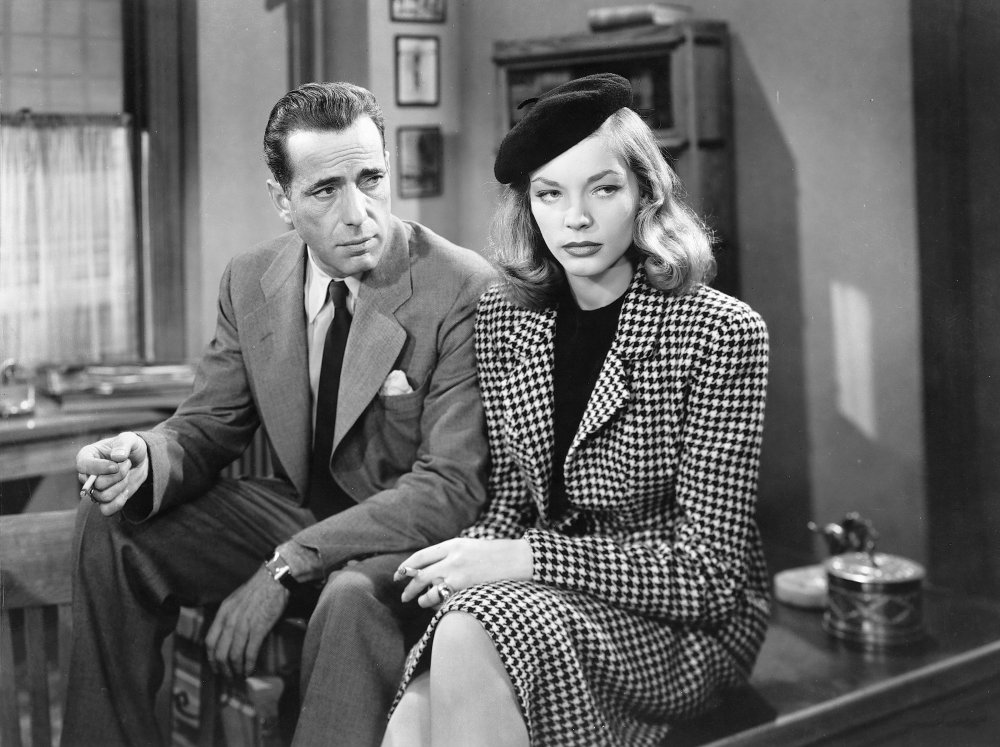
The Big Sleep (1946)
It is at this point that things begin to get muddy, and there are good reasons for the famous illogic of the second half of The Big Sleep – most of them having to do with the Hollywood Production Code. The novel is much more explicit and pointed. But the mood is nevertheless conveyed by the film even if the specific politics of the novel aren’t, and that is what counts most. As Marlowe tracks down the various tangled relationships among the Sternwood family (all three of them bound together by the tensions between them), Eddie Mars, and Agnes and her new accomplice Harry Jones (Elisha Cook, Jr.), it becomes painfully evident that there are no heroes here, only a kind of determinist sink in which, at various times, one group or another temporarily scratches its way to the top, lying, cheating and stealing with more aplomb than the others.
On the one hand, the surface mystery: why is Carmen being blackmailed? On the other, the deep mystery: Let’s begin with what Eddie Mars has on you – and by extrapolation, what you have on Eddie Mars, what you have on your father, what he has on your sister, what she has on you…This is the epitome of the ‘private eye’ movie. Chinatown, for example, exhibits the same dual-level structure: the surface mystery of the client is not the main focus of the film; the deep mystery – in this case profoundly political – is what counts. The intimations of incest are made explicit in Chinatown and, in a surprising reversal, the drugs and sex which are the matrix of the decadent atmosphere of The Big Sleep (explicitly in the novel, implicitly in the film) are replaced in the 70s homage to the film by rather cold family and municipal politics. The nausea that Bogart Marlowe evinced in the 40s has become, by the 70s, an axiom of our collective emotional existence. Gittes is not surprised so much by what he discovers lurking beneath the placid surface of sleepy Los Angeles. Instead, the focus of the later film is on the detective’s inability to control events. Whereas Marlowe was able, eventually, to set up a denouement that satisfied, Chinatown is marked by a progressive sense of futility: Gittes’ plans don’t work and the denouement, if it can be called that, is a matter of deus ex machina, imposed on the story rather than growing organically from it.
Gittes, it might be added, nevertheless comes a lot closer to the original Bogartian spirit of Marlowe than does Elliott Gould’s parody of the character in The Long Goodbye. Gittes, it’s true, is a bright-eyed, successful divorce shamus, with a sharp eye for the main chance, but he is also rather fresh-faced and naive, so we can forgive him those un-Bogartian faults. Chinatown is, in a sense, his initiation rite, and we can expect that a sequel would reveal a more sombre J.J. Gittes, a man who then would share with his brother the Bogartian Marlowe the fearful knowledge that they are both very much alone in the hothouse of Los Angeles, that the legal system is ‘inoperative’ when it comes to big boys like Noah Cross, and that there isn’t going to be anything like real justice. “Not in this town,” as Chandler wrote, “not in any town half this size, in any part of this wide, green and beautiful U.S.A. We just don’t run our country that way.”
Gould’s Marlowe, on the other hand, understands this as axiomatic; he is a child of the hip 60s, after all. It is just because he accepts this knowledge that he can’t convey the same sense of hurt and loneliness and courage in the face of them that made Bogart’s Marlowe so eminently attractive. He is too hard, too sharp; much closer in atmosphere to Sam Spade than to Philip Marlowe. Setting Chinatown in the 30s, Towne was free to give us an innocent, ‘proto-Marlowe’ hero. In a contemporary setting, Leigh Brackett and Robert Altman had to give us a ‘post-Marlowe’ parody.
~
In between The Big Sleep and its modem evocations in the 1970s, the genre had become degraded. During the 1950s the detective correlatives – Fritz Lang’s The Big Heat may be the best example – were marked by a vicious and righteous sense of retribution. The aim was not, as it had been in the 40s, to understand the phenomenon of cultural decay by working through the mystery, but to begin in medias res, at ‘white heat’, and wreak vengeance on the villainous products of that ecological sink. Only recently have we been able to rediscover the existential balance and self-respect that Bogart represented 30 years ago. Since that righteous sense of revenge that was born in the 50s still greatly colours nearly all the examples of the genre that pervade American television, it is no surprise that Towne felt it necessary to set Chinatown in the period of the 30s. We do not yet quite accept a Bogartian reserve in our heroes in the 70s; we still prefer the orgasmic, simplistic violence of Clint Eastwood and Charles Bronson.
Yet The Big Sleep still lives, its mythic resonances have not lost their appeal, and this means that the quasi-fascist detective story of the 50s has not completely forced out the more balanced, thoughtful, consequential 1940s model. And as the epitome of a Howard Hawks movie, The Big Sleep exhibited all the varied facets of his technical dramatic skill. Scenes are edited sharply and economically, designed to give viewers all the necessary information and no more. Frames are composed with similar efficiency, organised around the action, focusing clearly on the characters and the interaction between them. But above all, The Big Sleep shows itself to be the quintessential Hawks film by the colour, precision and richness of its dialogue. The rapid fire delivery that had been the basis of the humour of the screwball comedies is mirrored here with greater subtlety of effect. Building on Raymond Chandler’s already meaty, witty exchanges, screenwriters Faulkner, Brackett and Furthman further enriched the ore; Hawks and his actors refined it.
Like many of Howard Hawks’ films, The Big Sleep is almost better to listen to than to watch. Hawks was obsessed with gritty evocative, ironic dialogue. His favourite novelists were, he says, Hemingway, Hammett and Chandler. More than most directors he sought out and employed the most talented screenwriters, many of whom had had, like Ben Hecht and Charles MacArthur, considerable stage experience. Hawks has explained many times in interviews that he thinks the scene is the basic unit of filmmaking: do the scene well and audiences won’t care about the rest. Talking about The Big Sleep he once said, “We made a picture that worked pretty well… and I never figured out what was going on, but I thought the basic thing had great scenes in it and it was good entertainment” (my italics). What made those scenes work (and they are numberless: Marlowe and Sternwood in the hothouse, Marlowe and Vivian in his office, Marlowe and Mars at Geiger’s house, for example) was the kind of dialogue that was so multi-layered that it could ring ironical changes on itself, at the same time that it was conveying basic information about necessary details of character and plot.
Hawks was very much involved in this. process. He made it a sort of game. He has described how he used to work with Hecht and MacArthur, for example: “We’d sit in a room and we’d work for two hours and then we’d play backgammon for an hour. Then we’d start again and one of us would be one character and one would be another character. We’d read our lines of dialogue and the whole idea was to try and stump other people, to see if they could think of some thing crazier than you could. And that is the kind of dialogue we used, and the kind that was fun.” When the script was complete, Hecht and MacArthur thought they were finished. Hawks told them, “We start again tomorrow.” “On what ?” they asked. ‘Different ways of saying things.”
These procedures led to the richness and flavour that mark most of Hawks’ great films. The Big Sleep is no exception: Marlowe’s exchange with Mars when he first meets him, this set speech of introduction for General Sternwood, the recurrent refrain with Vivian – indeed, all Bogart’s verbal battles with Bacall – all are distilled rhetoric, the kind of dialogue that gets remembered and repeated. It is all carefully planned and polished material: it is the aesthetic focus of the film and it carries it. Outside of the westerns, very few images from Hawks’ films are striking; it is the dialogue we remember. More than anyone else, Hawks made ‘talkies’. And that is why a Hawks film is more easily enjoyed by inexperienced audiences. You have to learn to watch films to enjoy to the fullest films as intellectually intriguing as Hitchcock’s or as visually impressive as Ford’s; but all you need is a minimal appreciation of fast language and smart badinage to like a talkie by Howard Hawks.
~
But what was all that talk about? Hawks is often noted for concentrating on male friendships and avoiding sexual relationships; certainly the early ‘war’ and gangster films and the later westerns do so, perforce. But at the height of his career Hawks gave us some of the strongest women characters in American movies and, moreover, he placed them in positions of intellectual equality with their male counterparts. That the films are often comedies in which both the male and female leads are made to appear to some extent ridiculous shouldn’t prevent us from noticing the balance Hawks achieved.
That sexual equation was most fascinating (and meaningful) in the Bogart-Bacall films. In fact, Hawks felt that the basic premise of The Big Sleep was not the mystery, not the figure of the private eye, but the tense and equal relationship between Humphrey Bogart and his ‘discovery’, Lauren Bacall. The genius of The Big Sleep was going to be the character of a woman “even more in solent than you,” he told Bogart.
It worked. Vivian Sternwood Rutledge is self-confident, sardonic and as cynical as Bogart’s Marlowe. And Hawks has surrounded her with women foils who re-emphasise this major theme of The Big Sleep. Agnes, the front-woman in Geiger’s bookstore, is one of the most active and persistent villains of the piece. Forced to work through men, she picks up and then discards first Joe Brody, then Harry Jones. Never, as she complains, can she find any one but a “half-smart guy. That’s all I ever draw. Never once a guy who’s smart all the way round the course. Never once.” In a better world Agnes would be free to do her own deals, but in this one she is forced to find men to act through.
The woman in the bookstore across the street from Geiger’s shop is equally forceful, in a more pleasant way. It is she who takes the initiative in her one gem of a scene with Philip Marlowe. “I see…” she says, deftly removing her glasses, “you begin to interest me.” She closes up shop as Marlowe breaks out his bottle of rye, and she enjoys the game every bit as much as he does. Even the taxi-driver whom Marlowe hires to tail Geiger’s car is a woman, and she is expert at her job.
Finally, Carmen is the closest foil to her sister Vivian; she shows us the darker side of the Sternwood character and she does it with considerable panache, never apologising for her actions, which if they were those of a male character would simply be put down to ‘sowing some wild oats’.
Within four years after The Big Sleep was released, a violent if unconscious backlash set in, and women’s roles in Hollywood films still haven’t recovered from what we might call the ‘Marilyn Monroe syndrome’. Unless we consider Gentlemen Prefer Blondes as wholly ironic, or seize on Paula Prentiss’ role in Man’s Favourite Sport, we have to admit that Hawks mirrored this destructive development just as accurately as he had reflected the rise in power of women’s roles in the late 30s and early 40s. Still, The Big Sleep remains a gallery of women who are just as ‘insolent’, just as competent and often just as sublimely amoral as any of the men in the film, which makes it some thing of a high-water mark for women’s roles in Hollywood.
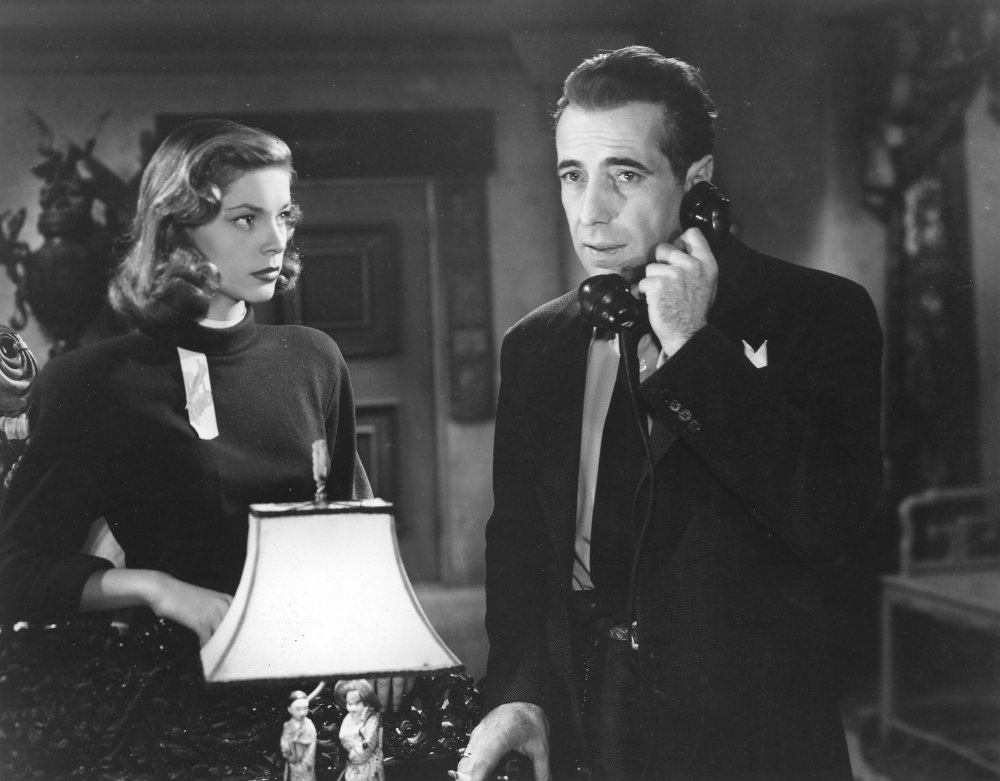
The Big Sleep (1946)
Yet even as The Big Sleep reflects the best elements of the Hollywood style, it also shows us why that style was becoming progressively effete. Despite all Hawks’ humorous protestations, and our critical awareness of the communicative function of style in his films, the fact is that the story does count: what one says is as important as how one says it. Raymond Chandler’s novel, compared with the film that was drawn from it, is a considerably more intriguing work in many respects. What could only be hinted at in a film made under the Production Code could be explicitly developed in an uncensored novel. To his discredit, Hawks not only had no reservations about the Code and its chilling effects but, when the Breen office didn’t like Chandler’s ending, he asked them jokingly to suggest one in place of it – liked it, and used it. “I’ll hire you fellows as writers,” he says he told them.
Chandler’s Big Sleep is more specific about the facts of the organically decadent world in which Marlowe somehow survives. Carmen did murder Regan. (The film suggests this, then switches the blame breathlessly to Mars.) She is more evidently a nymphomaniac in the novel, and it is also clear that Geiger is running a pornographic bookshop and dealing in sex and drugs on the side; that Carol Lundgren is Geiger’s lover (which gives Carol a motive for murdering Joe Brody); that Vivian’s ex husband was Regan (which makes the General’s interest in him explicable); and that Carmen was fond of ether and laudanum cocktails. Much of the illogic of the film is simply due to cuts which were made in order to conform to the Code. (Although not all the murkiness is the result of the script: when it occurred to Hawks and his cast in the middle of shooting that nobody had the slightest idea who killed Owen Taylor, the Sternwood chauffeur, they called Chandler. He didn’t know either.)
Most important, however, is the excision of what was for Chandler obviously a very significant subplot. He devotes several chapters to Marlowe’s relationship with the police and the district attorney’s office, in which he makes it painfully clear that one of Marlowe’s main motives for being a private detective is that the public detectives are pretty thoroughly corrupt. After Marlowe has ‘solved’ the first mystery (who killed Geiger and Brody and why), Chandler spends a chapter explaining how the story was finally released to the press: a complete fabrication meant to protect the Sternwood family, who obviously own a share in the L.A. police. (In Chinatown, incidentally, Noah Cross’ daughter tells Gittes that her father ‘owns the police’.)
The second half of the book then makes more sense. Marlowe has the best of motives for sticking with the case: he may be cynical, but he is also infuriated about the fictions the police invent for the public and about the special relationship between the Sternwoods and the cops. In short, there is a sharp political point to Raymond Chandler’s novel which is thoroughly blunted in Hawks’ film. It would be nearly three decades before Hollywood’s ethos would change enough to allow these politics in Chinatown.
Ironically, but all too significantly, the ending the Production Code people suggested was much more violent than Chandler’s political conclusion. In this sense, as well, The Big Sleep is an accurate epitome of Hollywood movies: when the filmmakers allowed themselves to be censored, when they eagerly learned the lesson that a commodity like violence could be more commercially valuable than a commitment to political realities, they were offering themselves up smiling for emasculation. That is the ultimate failure of Hollywood, and probably of Howard Hawks as well.
~
Yet despite these failures, because it is a kind of second-generation screwball comedy; because it is the ultimate Bogart-Bacall film; because it has some relatively advanced sexual politics; because it is a classic private-eye film; because it prefigures the film noir of the next decade; and because it is a concentrated model of Howard Hawks’ stylish storytelling, The Big Sleep is a landmark film. It is “good, clean, direct, functional cinema” (to quote Andrew Sarris’ comment on Hawks) but it is also a major example of the intriguing and vital resonances that the ‘craft’ could produce during the best years of the Hollywood style.
When Noel Coward, no slouch at writing dialogue himself, asked Hawks what he called the kind of dialogue he used, Hawks replied: “Hemingway calls it ‘oblique dialogue’. I call it three-cushion.” The implied comparison with Hemingway and the sports metaphor which Hawks uses to refer to his own work are both significant. (It’s also no accident that the best film version of a Hemingway book is still Hawks’s To Have and Have Not.) They shared a way of looking at the world – and responding to it – which represents a whole set of American cultural attitudes, a set which is still current in the 70s, even if we associate it more closely with the roles Bogart played 30 years ago.
The aesthetic device that both Hemingway and Hawks found most evocative of that Bogartian attitude towards the world was ‘oblique, three-cushion dialogue.’ It reflects a world of isolation and indirection, of closed spaces and mistaken purposes, in which pain is chronic, but often treated with defensive irony; a world of actions rather than feelings, in which professions and jobs are important because they are the first line of defence against the pervasive anxiety; a world of journeys to be made, races to be run, duties to be met. It is almost as though both Hawks and Hemingway themselves hid behind their technique, just as their characters use their expertise as a shield against the meaninglessness through which they daily walk.
No doubt the pain of the irony is more apparent in Hemingway, but there is a smell of it always in Hawks’ work as well. And that existential odour gives his movies – especially The Big Sleep – a pungency and dimension that they would not otherwise have. No doubt Howard Hawks will be best remembered as the ultimate Hollywood craftsman. Yet there is a thin but vital strain which makes his films much more than the jewelled, efficiently functioning storytelling machines that they evidently are. Sometimes the emptiness shows through the cracks in the bright laughter; sometimes the breathless dialogue stops cold and the people are left bare of that protective shell. Very seldom, but sometimes.
-
The Digital Edition and Archive quick link
Log in here to your digital edition and archive subscription, take a look at the packages on offer and buy a subscription.




